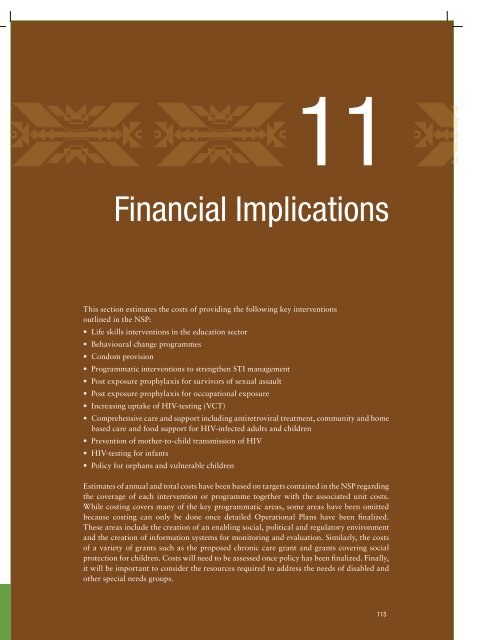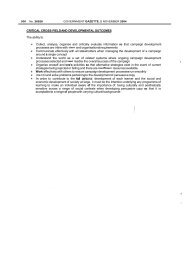Financial Implications
Financial Implications
Financial Implications
You also want an ePaper? Increase the reach of your titles
YUMPU automatically turns print PDFs into web optimized ePapers that Google loves.
XXXXXXXX<br />
CHAPTER NAME<br />
11<br />
<strong>Financial</strong> <strong>Implications</strong><br />
This section estimates the costs of providing the following key interventions<br />
outlined in the NSP:<br />
• Life skills interventions in the education sector<br />
• Behavioural change programmes<br />
• Condom provision<br />
• Programmatic interventions to strengthen STI management<br />
• Post exposure prophylaxis for survivors of sexual assault<br />
• Post exposure prophylaxis for occupational exposure<br />
• Increasing uptake of HIV-testing (VCT)<br />
• Comprehensive care and support including antiretroviral treatment, community and home<br />
based care and food support for HIV-infected adults and children<br />
• Prevention of mother-to-child transmission of HIV<br />
• HIV-testing for infants<br />
• Policy for orphans and vulnerable children<br />
Estimates of annual and total costs have been based on targets contained in the NSP regarding<br />
the coverage of each intervention or programme together with the associated unit costs.<br />
While costing covers many of the key programmatic areas, some areas have been omitted<br />
because costing can only be done once detailed Operational Plans have been finalized.<br />
These areas include the creation of an enabling social, political and regulatory environment<br />
and the creation of information systems for monitoring and evaluation. Similarly, the costs<br />
of a variety of grants such as the proposed chronic care grant and grants covering social<br />
protection for children. Costs will need to be assessed once policy has been finalized. Finally,<br />
it will be important to consider the resources required to address the needs of disabled and<br />
other special needs groups.<br />
115<br />
115
HIV & AIDS AND STI STRATEGIC PLAN 2007-2011<br />
The key driver of costs is adult antiretroviral treatment, at approximately 40% of the total<br />
cost. The second-most expensive programme (7% of the total) relates to the support of<br />
orphans and vulnerable children thus emphasizing the importance of safeguarding families<br />
through delaying maternal and paternal mortality.<br />
The cost implications of the NSP are large, in some options exceeding 20% of the health<br />
budget without considering the costs arising from the effect of the epidemic on hospital and<br />
primary care services. In attempting to increase the feasibility of this plan, some of the key<br />
considerations are:<br />
• Extending prevention programmes and getting them to work is critical to reduce long-term<br />
morbidity and costs. A simple example is PMTCT. If this programme was functioning<br />
properly, it would radically reduce paediatric AIDS cases.<br />
• Innovative financing arrangements such as partnerships with the key donors (Global Fund<br />
to Fight AIDS, TB and malaria and PEPFAR) as well as partnerships with the private<br />
health sector, business and a range of other stakeholders is crucial.<br />
• Attention should be placed on increasing the affordability of medicines.<br />
• To enhance efficiency, attention must be given to strengthening the primary health care<br />
infrastructure so that the location of care can be shifted out of hospitals into quality<br />
primary health care services, especially at the community health centre level. This will also<br />
improve the accessibility of the service to patients.<br />
• Improved monitoring and evaluation is essential to show value for money for the large<br />
amount of resources being allocated to the programme. In addition, weaknesses in existing<br />
monitoring and evaluation systems makes it very difficult to adequately cost the NSP<br />
because of uncertainty around baseline performance and outputs.<br />
Attention needs to be given to programmes to improve adherence to treatment; poor<br />
compliance and associated rapid development of resistant strains would lead to increasing<br />
reliance on more expensive lines of treatment.<br />
Total Costs<br />
Table 3 and Table 4 outline the costs of the key interventions contained in this report,<br />
grouped according to priority areas (e.g. prevention), goals (e.g. reduce HIV transmission)<br />
and interventions (e.g. post-exposure prophylaxis) contained in the NSP.<br />
In Table 3, low cost scenarios are summarized, with the key difference relating to the<br />
assumption of only 60% of new AIDS cases receiving ART by 2011. In Table 4, high cost<br />
scenarios are summarized, where 80% of new AIDS cases receive ART by 2011.<br />
116
FINANCIAL IMPLICATIONS<br />
When considering these costs, the following points should be borne in mind:<br />
• Home-based care and ART treatment will avert the inpatient care costs that would have<br />
been incurred for patients in the absence of these interventions.<br />
• Some estimates need to be revised once Operational Plans have been developed.<br />
• Costs relating to the creation of an enabling political, social and regulatory environment<br />
and monitoring and evaluation systems have not been included.<br />
• During the Operational Plan, it will also be important to pay attention to the needs of<br />
disabled and other special needs groups.<br />
The key driver of costs is adult antiretroviral treatment, at approximately 40% of the total<br />
cost. The second-most expensive programme (7% of the total) relates to the support of<br />
orphans and vulnerable children thus emphasizing the importance of safeguarding families<br />
through delaying maternal and paternal mortality.<br />
Table 3: Summarized total costs for the low-cost scenarios (million Rands, 2005/06 prices)<br />
117
HIV & AIDS AND STI STRATEGIC PLAN 2007-2011<br />
Table 4: Summarized total costs for the high-cost scenarios (million Rands, 2005/06 prices)<br />
118

















